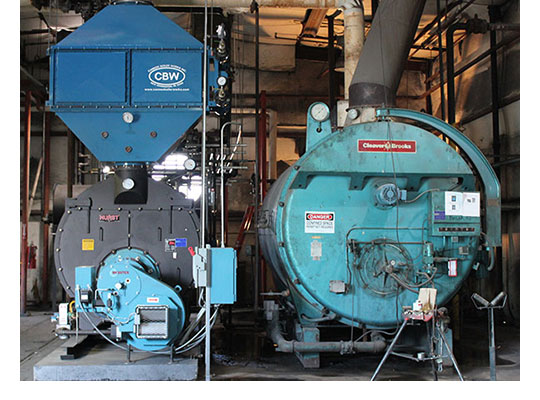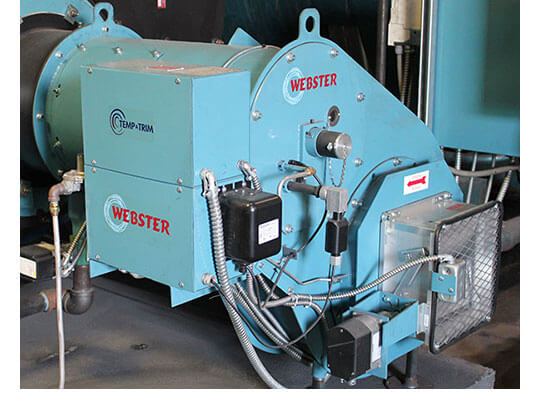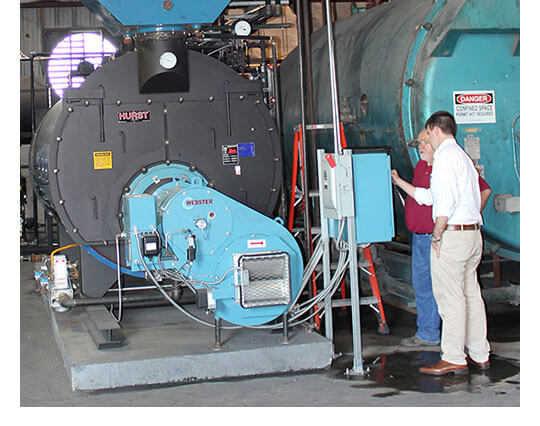Vibracoustic Saves Over $150,000/Year in Fuel Costs on a Single Boiler
 New Hurst boiler with Webster burner, left, next to old Cleaver Brooks boiler
New Hurst boiler with Webster burner, left, next to old Cleaver Brooks boiler
Vibracoustic, a global manufacturer of products for the worldwide automotive industry, specializing in anti-vibration components, mounts, link arm assemblies, and related products, has 10,000 employees at 43 sites in 19 countries worldwide. The company runs two facilities located in Morganfield, Kentucky – one that molds rubber components and one that applies adhesives to metal parts to bond the molded rubber – supplying all of its other North American factories. The adhesive plant coats about 800 different items.
The Kentucky adhesives plant had been using a Cleaver Brooks boiler installed in the mid-1980s, prior to the time that Vibracoustic took occupancy. The 400HP boiler was used to create steam primarily for heating the phosphate treatment line and for heat exchangers in the drying process. Because of the increasing cost of natural gas, a decision was made in 2013 to replace the boiler with a new one that was properly sized for the plant’s needs, with some room for growth.
Doug Harre, Vibracoustic’s resident plant engineer responsible for the project, researched new boilers and decided on a Hurst boiler because he felt it was the best option. He believed the 4-pass wet-back boiler design would be much easier to maintain, since it had no refractory in the rear of the boiler to repair or eventually replace, and the Hurst reputation of success in industrial applications was well known.
Once the boiler decision was made, Harre then did extensive research into different burners and boiler accessories to determine the most energy efficient package possible. Said Harre, “Our primary motivation was to update the older boiler to something more reasonably sized and also to improve our energy efficiency.” Mr. Harre’s research led him to choose Webster Combustion Technology for the burner on his new boiler.
Harre worked with a local combustion representative, Cici Boiler Rooms, in Evansville Indiana, about an hour’s drive from the plant. “They recommended Webster and the package I asked them to quote. We require 3 competitive bids on any project so I was looking at various boilers and various suppliers. As I researched them further, I really liked the Webster. There’s a lot of things involved and, understanding combustion theory and process as well as I do, I liked that they added extra things they pointed out to me, such as the advantage of being able to control air intake and gas metering separately via the Siemens controller on the drive instead of through mechanical linkages. I asked for a lot of information and they provided it, then we discussed it. It was very enlightening.
Cici Boiler Rooms took Mr. Harre around to see other Hurst / Webster packages in operation in his area. They visited several hospitals as well as a large corn chip manufacturing company that used the same type of Hurst boiler and Webster burner. “It was nice to be able to see the installations directly and discuss them with the people who had experience with them.”
 Webster high-efficiency boiler burner with Temp-A-Trim, Webster’s automatic air density trim system
Webster high-efficiency boiler burner with Temp-A-Trim, Webster’s automatic air density trim system
“One of the additions I included on the burner was Webster’s Temp-A-Trim™ system which compensates for variations of air density. That was a feature that I really like on the burner. But if you don’t understand thermal dynamics, it’s one of those things that most people will overlook. They don’t see it as being an important item where it actually can contribute quite a bit to your performance savings. It added some initial cost, sure, but the long-term savings more than make up for it.”
The Temp A Trim system works by adjusting the combustion air input based on air density changes to optimize the combustion process, thereby saving fuel and electricity, and reducing performance issues caused by air temperature fluctuations.
Continued Harre, “I was really impressed with the Webster burner and its systems. Its servo drives and other bells and whistles make it considerably more energy efficient than others I researched. In the end, I chose the best burner for its capabilities. And then I also added a few other options into the boiler purchase as I researched it further, such as an economizer to cut the flue gas temperature down and re-utilize that in preheating the area of the tank to supply the boiler.” Harre specified a proven economizer model from Canon Boiler Works, based on its heat recovery performance expected on this installation.
While natural gas prices have been falling around the country for a number of years, Vibracoustic already had negotiated fairly decent energy rates from its municipal supplier, so while prices have come down some recently, the difference wasn’t that significant for them. Said Harre, “We had renegotiated our pricing with the city, and at the same time, we had other equipment that used natural gas. So we were looking at a number of opportunities to reduce our impact further.”
 The new Hurst boiler is half the size of the old boiler, but much more efficient
The new Hurst boiler is half the size of the old boiler, but much more efficient
In evaluating bids, Harre first looks at purchase price and installation costs to understand exactly how much it’s going to run to do the installation. “I ran efficiency evaluations for each unit and each brand I looked at. With the Hurst boiler and the Webster burner control, everything was a perfect fit.” The installation went very well because Cici was able to make provisions to avoid shutting down production during installation.
Harre also considers long term costs and serviceability to be key elements of a bid evaluation. “If I have somebody who is very familiar with the unit and we have any issue, it’s important that they can be here fast. Spare parts availability is another aspect that I figured into the cost because I have to minimize my inventory yet we have to be available to run 24/7, so that’s another reason local support is very important to me.”
The old boiler was a Cleaver Brooks 400HP 4-pass dry-back model. The new Hurst / Webster package is half the size at 200HP. “More efficient and still larger than my needs by about 100 horsepower. I wanted to give myself plenty of room for growth on that boiler,” said Harre.
Once the equipment was installed, Harre put an individual gas meter on the boiler itself and was amazed at how much they cut down on their energy consumption on that boiler alone. All of the energy savings features he added to the system are paying off in a big way and Vibracoustic is quickly reaping the benefits of their new equipment.
For Vibracoustic and their adhesives plant in Morganfield, KY, the upgrade to their boiler package has added up to smooth operations and big savings. “Total overall consumption reduction was over $150,000 per year”, said Harre. With savings like that, this upgrade will be paid for in no time!


